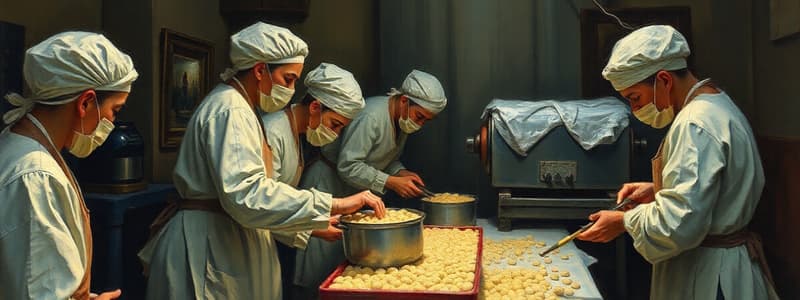Podcast
Questions and Answers
Why is it important to separate clean and dirty areas in a production environment?
Why is it important to separate clean and dirty areas in a production environment?
- To facilitate employee movement.
- To reduce product variety.
- To prevent cross-contamination. (correct)
- To increase production speed.
What is the preferred method for minimizing product flow paths?
What is the preferred method for minimizing product flow paths?
- Curved and lengthy routes.
- Multiple intersecting paths.
- Variable routes based on product type.
- Straight lines. (correct)
Why should employee movement be limited in a production area?
Why should employee movement be limited in a production area?
- To increase productivity.
- To prevent potential contamination. (correct)
- To reduce stress on workers.
- To shorten work hours.
What is a key requirement for entering high-cleanliness areas?
What is a key requirement for entering high-cleanliness areas?
What is a benefit of having separate pathways for different types of employees?
What is a benefit of having separate pathways for different types of employees?
What is emphasized concerning waste storage in a production environment?
What is emphasized concerning waste storage in a production environment?
What is a significant factor to consider when establishing product specifications?
What is a significant factor to consider when establishing product specifications?
What essential procedure must be implemented to prevent transfer or buildup of contaminants?
What essential procedure must be implemented to prevent transfer or buildup of contaminants?
How should visitor areas be managed in a food processing environment?
How should visitor areas be managed in a food processing environment?
What is a crucial aspect of quality control in a food processing environment?
What is a crucial aspect of quality control in a food processing environment?
Flashcards
Zoning in food production
Zoning in food production
Preventing contamination by separating areas with different cleanliness levels.
Product Flow Path
Product Flow Path
The path a product takes from its origin to packaging or use, minimizing opportunities for contamination.
Preventing Product/Waste Interaction
Preventing Product/Waste Interaction
Keeping food and waste separate to prevent contamination.
Limited Employee Movement
Limited Employee Movement
Signup and view all the flashcards
Shortest Employee Routes
Shortest Employee Routes
Signup and view all the flashcards
Proximity of Changing Areas
Proximity of Changing Areas
Signup and view all the flashcards
Dedicated Areas for Different Workers
Dedicated Areas for Different Workers
Signup and view all the flashcards
Separated paths for employees
Separated paths for employees
Signup and view all the flashcards
Waste and byproduct flow
Waste and byproduct flow
Signup and view all the flashcards
Proper Waste Storage
Proper Waste Storage
Signup and view all the flashcards


